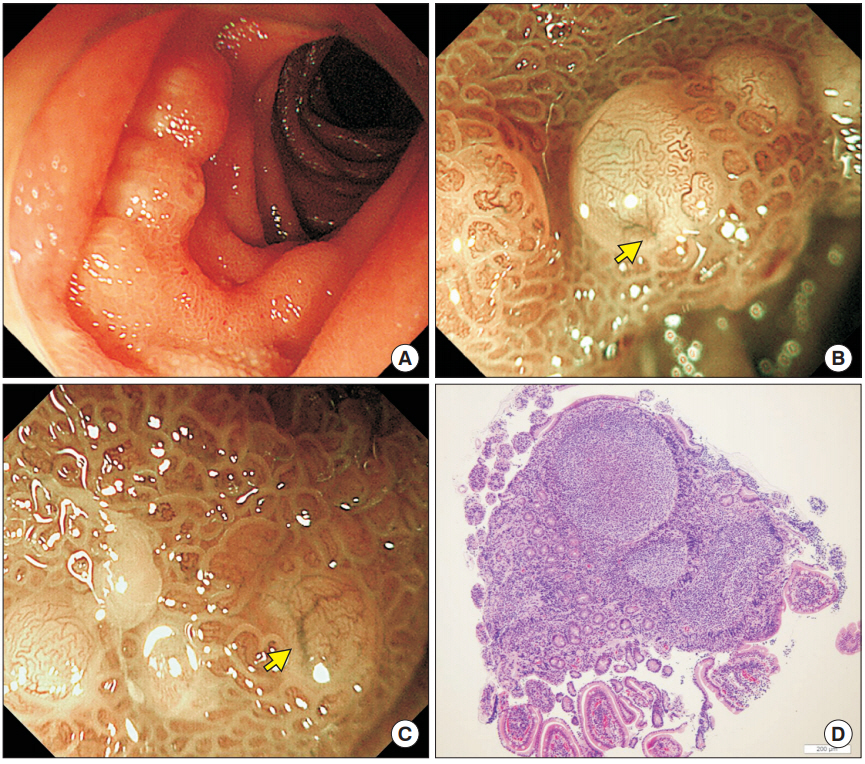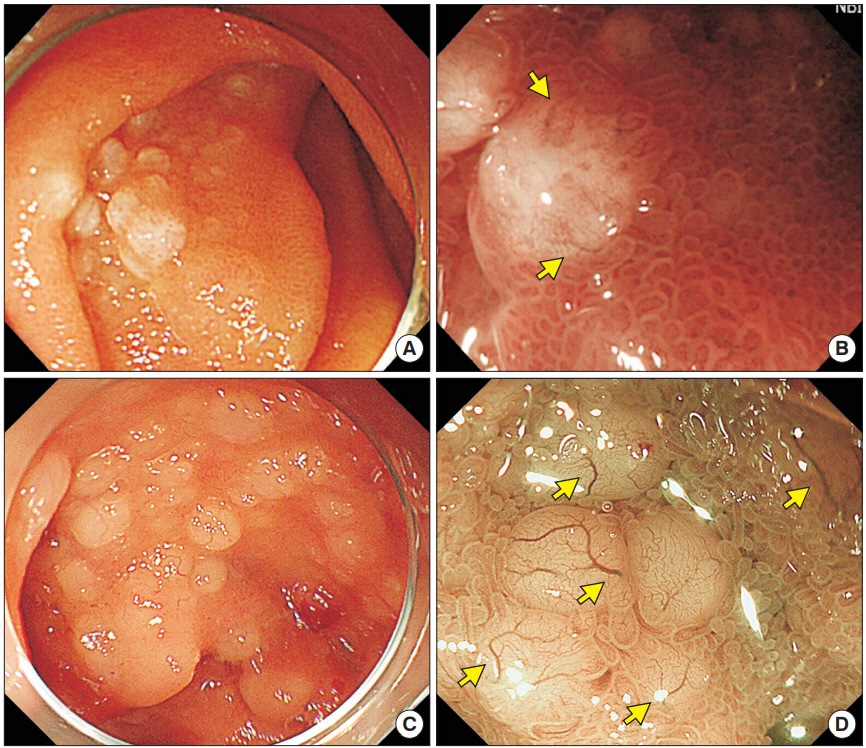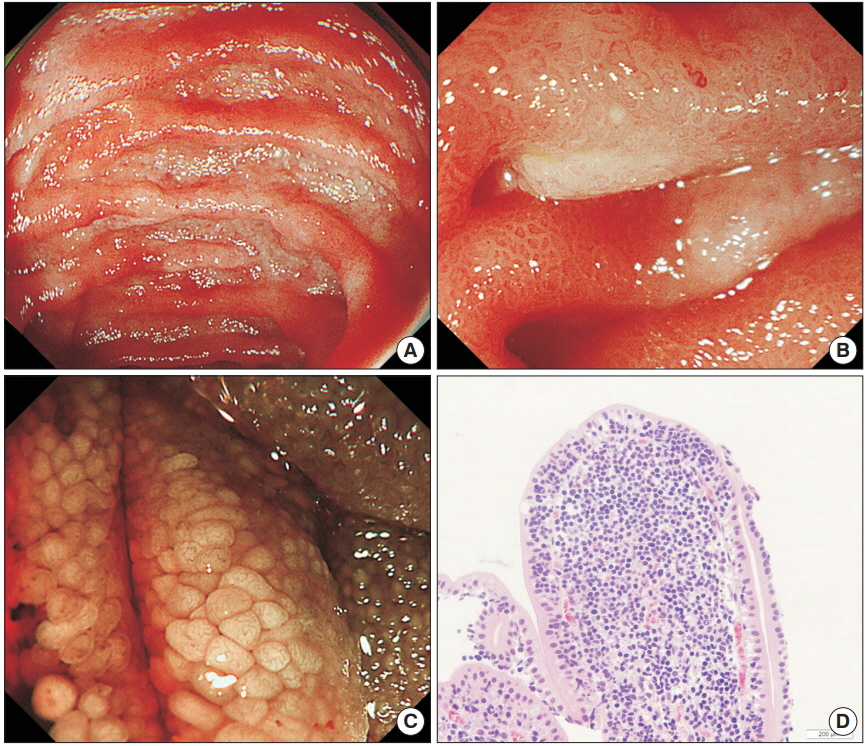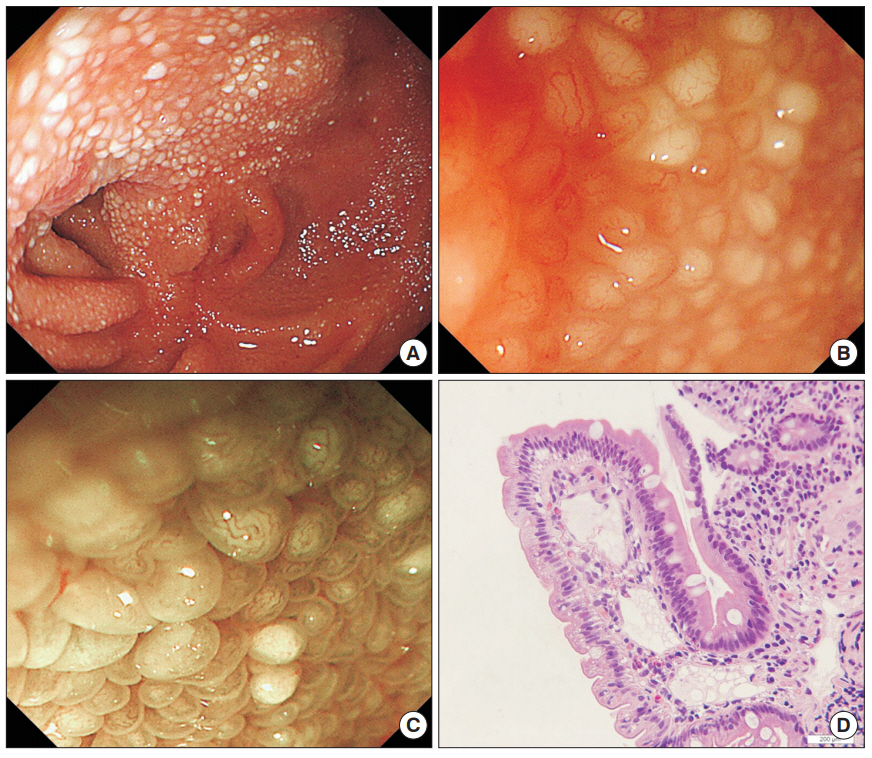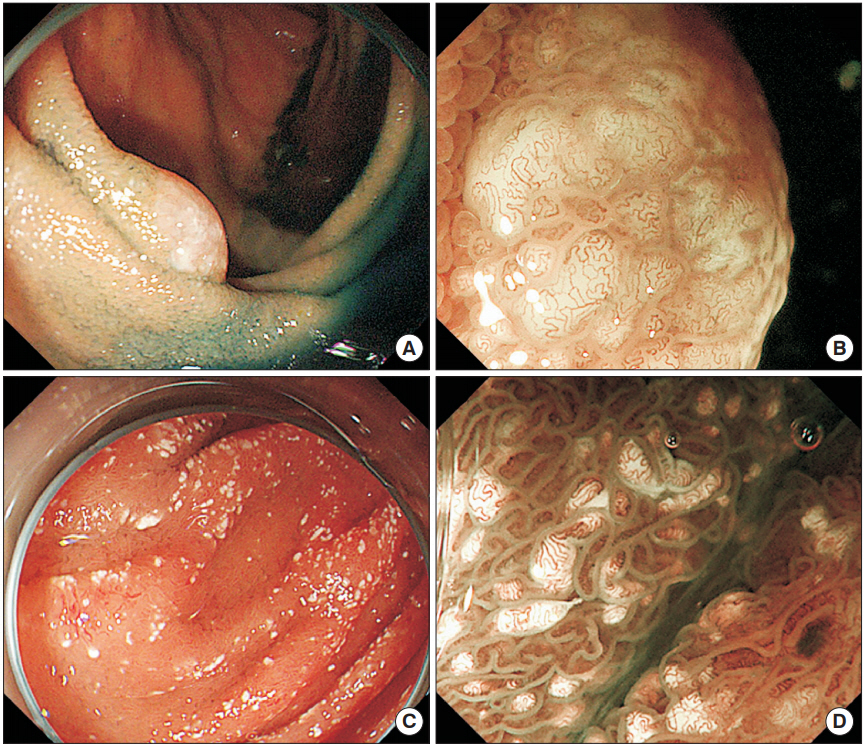Intest Res.
2018 Oct;16(4):628-634. 10.5217/ir.2018.00003.
Magnified single-balloon enteroscopy in the diagnosis of intestinal follicular lymphoma: a case series
- Affiliations
-
- 1Department of Medicine, Shiga University of Medical Science, Otsu, Japan.
- 2Division of Clinical Nutrition, Shiga University of Medical Science, Otsu, Japan. sb@belle.shiga-med.ac.jp
- 3Department of Comprehensive Internal Medicine, Shiga University of Medical Science, Otsu, Japan.
- 4Division of Diagnostic Pathology, Shiga University of Medical Science, Otsu, Japan.
- 5Division of Digestive Endoscopy, Shiga University of Medical Science, Otsu, Japan.
- KMID: 2434165
- DOI: http://doi.org/10.5217/ir.2018.00003
Abstract
- The objective of this study was to evaluate the magnified endoscopic findings in the diagnosis of follicular lymphoma in the small intestine in comparison with those of intestinal follicular lymphoma and lymphangiectasia. Four patients with follicular lymphoma and 3 with lymphangiectasia in the small intestine were retrospectively analyzed. A prototype magnifying singleballoon enteroscope was used. The findings of the intestinal follicular lymphoma and lymphangiectasia were retrospectively analyzed to determine the magnified endoscopic findings of follicular lymphoma in the small intestine. Opaque white granules were observed in 3 of the 4 patients with follicular lymphoma. Magnified narrow-band imaging (NBI) of the opaque white granules showed stretched microvessels, which had a diminutive tree-like appearance. The remaining patient had no opaque white granules and only displayed whitish villi. Magnified NBI observation of the whitish villi revealed the absence of marginal villus epithelium, which was confirmed by histology. The magnified NBI enteroscopy revealed the diminutive tree-like appearance on the opaque white granules and the absence of marginal villus epithelium of the whitish villi in intestinal follicular lymphoma. These findings may be useful in diagnosing follicular lymphoma.
MeSH Terms
Figure
Reference
-
1. Yamamoto H, Sekine Y, Sato Y, et al. Total enteroscopy with a nonsurgical steerable double-balloon method. Gastrointest Endosc. 2001; 53:216–220.
Article2. Tsujikawa T, Saitoh Y, Andoh A, et al. Novel single-balloon enteroscopy for diagnosis and treatment of the small intestine: preliminary experiences. Endoscopy. 2008; 40:11–15.
Article3. Yamamoto S, Nakase H, Yamashita K, et al. Gastrointestinal follicular lymphoma: review of the literature. J Gastroenterol. 2010; 45:370–388.
Article4. Chowdhury M, Endo M, Chiba T, et al. Characterization of follicular lymphoma in the small intestine using double-balloon endoscopy. Gastroenterol Res Pract. 2009; 2009:835258.
Article5. Iwamuro M, Okada H, Kawano S, et al. A multicenter survey of enteroscopy for the diagnosis of intestinal follicular lymphoma. Oncol Lett. 2015; 10:131–136.
Article6. Inoue N, Isomoto H, Shikuwa S, Mizuta Y, Hayashi T, Kohno S. Magnifying endoscopic observation of primary follicular lymphoma of the duodenum by using the narrow-band imaging system. Gastrointest Endosc. 2009; 69:158–159.
Article7. Norimura D, Isomoto H, Imaizumi Y, et al. Case series of duodenal follicular lymphoma, observed by magnified endoscopy with narrow-band imaging. Gastrointest Endosc. 2011; 74:428–434.
Article8. Iwamuro M, Okada H, Takata K, et al. Magnified endoscopic features of duodenal follicular lymphoma and other whitish lesions. Acta Med Okayama. 2015; 69:37–44.9. Tada M, Suyama Y, Shimizu T, et al. Observation of the villi with the magnifying entero-colonoscopes. Gastroenterol Endosc. 1980; 22:647–654.10. Murata M, Bamba S, Takahashi K, et al. Application of novel magnified single balloon enteroscopy for a patient with Cronkhite-Canada syndrome. World J Gastroenterol. 2017; 23:4121–4126.
Article11. Asakura H, Miura S, Morishita T, et al. Endoscopic and histopathological study on primary and secondary intestinal lymphangiectasia. Dig Dis Sci. 1981; 26:312–320.
Article12. Iwamuro M, Okada H, Takata K, et al. Magnifying endoscopic observation of duodenal involvement of follicular lymphoma before and after chemotherapy. Intern Med. 2015; 54:1741–1745.13. Nonaka K, Ishikawa K, Arai S, et al. A case of gastric mucosaassociated lymphoid tissue lymphoma in which magnified endoscopy with narrow band imaging was useful in the diagnosis. World J Gastrointest Endosc. 2012; 4:151–156.
Article14. Iwamuro M, Okuda M, Yumoto E, et al. Magnifying endoscopy for intestinal follicular lymphoma is helpful for prompt diagnosis. Gut Liver. 2013; 7:258–261.
Article
- Full Text Links
- Actions
-
Cited
- CITED
-
- Close
- Share
- Similar articles
-
- Does Single Balloon Enteroscopy Have Similar Efficacy and Endoscopic Performance Compared with Double Balloon Enteroscopy?
- Magnifying Endoscopy for Intestinal Follicular Lymphoma Is Helpful for Prompt Diagnosis
- A Case of Jejunal Extranodal MALT Lymphoma Diagnosed by Single-balloon Enteroscopy
- A Case of Primary Intestinal Lymphangiectasia Diagnosed by Double Balloon Enteroscopy
- A Case of a Meckel's Diverticular Bleeding Diagnosed by the Use of Double Balloon Enteroscopy

